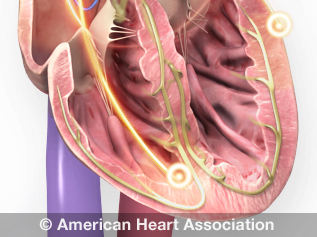Cardiac Resynchronization Therapy (CRT)
If you have heart failure and have developed arrhythmia, you may be a candidate for cardiac resynchronization therapy (CRT).

What is CRT and how can it help your heart?
Arrhythmias are irregular heart rhythms and can be caused by a variety of reasons, including age, heart damage, medications and genetics. In heart failure patients CRT, or biventricular pacing, is used to help improve the heart’s rhythm and the symptoms associated with the arrhythmia.
The procedure involves implanting a half-dollar sized pacemaker, usually just below the collarbone. Three wires (leads) connected to the device monitor the heart rate to detect heart rate irregularities and emit tiny pulses of electricity to correct them. In effect, it is “resynchronizing” the heart.
Benefits of CRT
Because CRT improves the heart’s efficiency and increases blood flow, patients have reported alleviations of some heart failure symptoms – such as shortness of breath. Clinical studies also suggest decreases in hospitalization and morbidity as well as improvements in quality of life.
Who is a candidate for CRT?
In general, CRT is for heart failure patients with moderate to severe symptoms and whose left and right heart chambers do not beat in unison. However, CRT is not effective for everyone and is not for those with mild heart failure symptoms, diastolic heart failure or who do not have issues with the chambers not beating together. It is also not suitable for patients who have not fully explored correcting the condition through medication therapies. To date, studies show CRT to be equally effective for both men and women.
To learn more
Talk with your doctor about your own suitability for CRT. He/She can take into account your unique medical history as well as age and desired level of intervention. CRT is also often combined with other treatments to achieve the best results.






